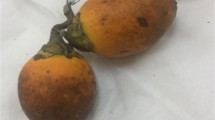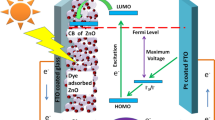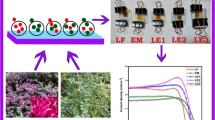Abstract
The effects of chenodeoxycholic acid (CDCA) in a dye solution as a co-adsorbent on the photovoltaic performance of dye-sensitized solar cells (DSSCs) based on two organic dyes containing phenothiazine and triarylamine segments (P1 and P2) were investigated. It was found that the coadsorption of CDCA can hinder the formation of dye aggregates and improve electron injection yield and thus J sc. This has also led to a rise in photovoltage, which is attributed to the decrease of charge recombination. The DSSC based on dye P2 showed better photovoltaic performance than P1: a maximum monochromatic incident photon-to-current conversion efficiency (IPCE) of 89.5%, a short-circuit photocurrent density (J sc) of 9.57 mA/cm2, an open-circuit photovoltage (V oc) of 697 mV, and a fill factor (FF) of 0.66, corresponding to an overall conversion efficiency of 4.42% under the standard global AM 1.5 solar light condition. The overall conversion efficiency was further improved to 5.31% (J sc = 10.36 mA/cm2, V oc = 0.730 V, FF = 0.70) upon addition of 10 mM CDCA to the dye solution for TiO2 sensitization. Electrochemical impedance data indicate that the electron lifetime was improved by coadsorption of CDCA, accounting for the significant improvement of V oc. These results suggest that interfacial engineering of the organic dye-sensitized TiO2 electrodes is important for highly efficient photovoltaic performance of the solar cell.
Similar content being viewed by others

References
O’Regan B, Grätzel M. A low-cost, high-efficiency solar cell based on dye-sensitized colloidal TiO2 films. Nature, 1991, 353(6346): 737–740
Ardo S, Meyer GJ. Photodriven heterogeneous charge transfer with transition-metal compounds anchored to TiO2 semiconductor surfaces. Chem Soc Rev, 2009, 38(1): 115–164
Hagfeldt A, Gräetzel M. Light-induced redox reactions in nanocrystalline systems. Chem Rev, 1995, 95(1): 49–68
Chiba Y, Islam A, Watanabe Y, Komiya R, Koide N, Han L. Dyesensitized solar cells with conversion efficiency of 11.1%. Jpn J Appl Phys, 2006, 45: L638
Nazeeruddin MK, Pechy P, Grätzel M. Efficient panchromatic sensitization of nanocrystalline TiO2 films by a black dye based on a trithiocyanato-ruthenium complex. Chem Comm, 1997, 18: 1705–1706
Kuang D, Klein C, Ito S, Moser JE, Humphry-Baker R, Evans N. High-efficiency and stable mesoscopic dye-sensitized solar cells based on a high molar extinction coefficient ruthenium sensitizer and nonvolatile electrolyte. Adv Mater, 2007, 19(8): 1133–1137
Nazeeruddin MK, Zakeeruddin SM, Humphry-Baker R, Jirousek M, Liska P, Vlachopoulos N, Shklover V, Fischer CH, Grätzel M. Acid-base equilibria of (2,2′-bipyridyl-4,4′-dicarboxylic acid)ruthenium (II) complexes and the effect of protonation on charge-transfer sensitization of nanocrystalline titania. Inorg Chem, 1999, 38(26): 6298–6305
Wang P, Klein C, Humphry-Baker R, Zakeeruddin SM, Grätzel M. A high molar extinction coefficient sensitizer for stable dye-sensitized solar cells. J Am Chem Soc, 2004, 127(3): 808–809
Hara K, Sayama K, Ohga Y, Shinpo A, Suga S, Arakawa H. A coumarin-derivative dye sensitized nanocrystalline TiO2 solar cell having a high solar-energy conversion efficiency up to 5.6%. Chem Comm, 2001, (6): 569–570
Wang ZS, Cui Y, Dan-oh Y, Kasada C, Shinpo A, Hara K. Thiophene-functionalized coumarin dye for efficient dye-sensitized solar cells: Electron lifetime improved by coadsorption of deoxycholic acid. J Phys Chem C, 2007, 111(19): 7224–7230
Wang ZS, Cui Y, Dan-oh Y, Kasada C, Shinpo A, Hara K. Molecular design of coumarin dyes for stable and efficient organic dye-sensitized solar cells. J Phys Chem C, 2008, 112(43): 17011–17017
Sarfati M, Courtieu J, Lesot P. First successful enantiomeric discrimination of chiral alkanes using NMR spectroscopy. Chem Comm, 2000, (13): 1113–1114
Wu WJ, Hua JL, Jin YH, Zhan WH, Tian H. Photovoltaic properties of three new cyanine dyes for dye-sensitized solar cells. Photochem Photobiol Sci, 2008, 7(1): 63–68
Horiuchi T, Miura H, Sumioka K, Uchida S. High efficiency of dyesensitized solar cells based on metal-free indoline dyes. J Am Chem Soc, 2004, 126(39): 12218–12219
Liu B, Zhu WH, Zhang Q, Wu WJ, Xu M, Ning ZJ, Tian H. Conveniently synthesized isophorone dyes for high efficiency dye-sensitized solar cells: Tuning photovoltaic performance by structural modification of donor group in donor-π-acceptor system. Chem Comm, 2009, (13): 1766–1768
Marinado T, Hagberg DP, Hedlund M, Edvinsson T, Johansson EMJ, Boschloo G, Rensmo H, Brinck T, Sun LC, Hagfeldt A. Rhodanine dyes for dye-sensitized solar cells: Spectroscopy, energy levels and photovoltaic performance. Phys Chem Chem Phys, 2009, 11(1): 133–141
Hara K, Sato T, Katoh R, Furube A, Yoshihara T, Murai M, Kurashige M, Ito S, Shinpo A, Suga S, Arakawa H. Novel conjugated organic dyes for efficient dye-sensitized solar cells. Adv Func Mater, 2005, 15(2): 246–252
Wang ZS, Li FY, Huang CH. Highly efficient sensitization of nanocrystalline TiO2 films with styryl benzothiazolium propylsulfonate. Chem Comm, 2000(20): 2063–2064
Yao QH, Meng FS, Li FY, Tian H, Huang CH. Photoelectric conversion properties of four novel carboxylated hemicyanine dyes on TiO2 electrode. J Mater Chem, 2003, 13(5): 1048–1053
Kim D, Lee JK, Kang SO, Ko J. Molecular engineering of organic dyes containing N-aryl carbazole moiety for solar cell. Tetrahedron, 2007, 63(9): 1913–1922
Kim S, Lee JK, Kang SO, Ko J, Yum JH, Fantacci S, De Angelis F, Di Censo D, Nazeeruddin MK, Grätzel M. Molecular engineering of organic sensitizers for solar cell applications. J Am Chem Soc, 2006, 128(51): 16701–16707
Choi H, Lee JK, Song K, Kang SO, Ko J. Novel organic dyes containing bis-dimethylfluorenyl amino benzo[b]thiophene for highly efficient dye-sensitized solar cell. Tetrahedron, 2007, 63(15): 3115–3121
Teng C, Yang XC, Yang C, Li SF, Cheng M, Hagfeldt S, Sun LC. Molecular design of anthracene-bridged metal-free organic dyes for efficient dye-sensitized solar cells. J Phys Chem C, 2010, 114(19): 9101–9110
Song JS, Zhang F, Li CH, Liu WL, Li BS, Huang BS, Bo ZS. Phenylethyne-bridged dyes for dye-sensitized solar cells. J Phys Chem C, 2009, 113: 13391–13397
Kitamura T, Ikeda M, Shigaki K, Inoue T, Anderson NA, Ai X, Lian T, Yanagida S. Phenyl-conjugated oligoene sensitizers for TiO2 solar cells. Chem Mater, 2004, 16(9): 1806–1812
Qin P, Zhu H, Edvinsson T, Boschloo G, Hagfeldt A, Sun L. Design of an organic chromophore for P-type dye-sensitized solar cells. J Am Chem Soc, 2008, 130(27): 8570–8571
Tian H, Yang X, Pan J, Chen R, Liu M, Zhang Q, Hagfeldt A, Sun LC. A triphenylamine dye model for the study of intramolecular energy transfer and charge transfer in dye-sensitized solar cells. Adv Func Mater, 2008, 18(21): 3461–3468
Velusamy M, Justin Thomas KR, Lin JT, Hsu Y-C, Ho K-C. Organic dyes incorporating low-band-gap chromophores for dye-sensitized solar cells. Org Lett, 2005, 7(10): 1899–1902
Alibabaei L, Kim JH, Wang M, Pootrakulchote N, Teuscher J, Censo DD, Humphry BR, Moser JE, Yu YJ, Kay KY, Zakeeruddin SM, Grtzel M. Molecular design of metal-free D-π-A substituted sensitizers for dye-sensitized solar cells. Energy Environ Sci, 2010, 11(3): 1757–1764
Qu SY, Wu WJ, Hua JL, Kong C, Long YT, Tian H. New diketopyrrolopyrrole (DPP) dyes for efficient dye-sensitized solar cells. J Phys Chem C, 2010, 114(2): 1343–1349
Zeng WD, Cao YM, Bai Y, Wang YH, Shi YS, Zhang M, Wang FF, Pan CY, Wang P. Efficient dye-sensitized solar cells with an organic photosensitizer featuring orderly conjugated ethylenedioxythiophene and dithienosilole blocks. Chem Mater, 2010, 22(5): 1915–1925
Wu WJ, Yang JB, Hua JL, Tang J, Zhang L, Long YT. Efficient and stable dye-sensitized solar cells based on phenothiazine sensitizers with thiophene units. J Mater Chem, 2010, 20(9): 1772–1779
Chen R, Yang X, Tian H, Sun LC. Tetrahydroquinoline dyes with different spacers for organic dye-sensitized solar cells. J Photochem Photobio A, 2007, 189(2–3): 295–300
Kay A, Gräetzel M. Artificial photosynthesis. 1. Photosensitization of titania solar cells with chlorophyll derivatives and related natural porphyrins. J Phys Chem, 1993, 97(23): 6272–6277
Wang P, Zakeeruddin SM, Comte P, Charvet R, Humphry-Baker R, Grätzel M. Enhance the performance of dye-sensitized solar cells by co-grafting amphiphilic sensitizer and hexadecylmalonic acid on TiO2 nanocrystals. J Phys Chem B, 2003, 107(51): 14336–14341
Wang P, Zakeeruddin S, Humphry-Baker R, Moser J, Grätzel M. Molecular-scale interface engineering of TiO2 nanocrystals: improve the efficiency and stability of dye-sensitized solar cells. Adv Mater, 2003, 15(24): 2101–2104
Wang P, Zakeeruddin SM, Humphry-Baker R, Grätzel M. A Binary ionic liquid electrolyte to achieve ⩾7% power conversion efficiencies in dye-sensitized solar cells. Chem Mater, 2004, 16(14): 2694–2696
He J, Benkö G, Korodi F, Polívka T, Lomoth R, Åkermark B, Sun LC, Hagfeldt A, Sundstrm V. Modified phthalocyanines for efficient near-IR sensitization of nanostructured TiO2 electrode. J Am Chem Soc, 2002, 124(17): 4922–4932
Bonhote P, Dias AP, Papageorgiou N, Kalyanasundaram K, Gratzel M. Hydrophobic, highly conductive ambient-temperature molten salts. Inorg Chem, 1996, 35(5): 1168–1178
Xu W, Peng B, Chen J, Liang M, Cai F. New triphenylamine-based dyes for dye-sensitized solar cells. J Phys Chem C, 2008, 112: 874–880
Hagberg DP, Yum J-H, Lee H, Angelis DF, Marinado T, Karlsson KM, Humphry-Baker R, Sun LC, Hagfeldt A, Grätzel M, Nazeeruddin M K. Molecular engineering of organic sensitizers for dye-sensitized solar cell applications. J Am Chem Soc, 2008, 130: 6259–6266
Wang ZS, Hara K, Danoh Y, Kasada C, Shinpo A, Suga S, Arakawa H, Sugihara H. Photophysical and (photo)electrochemical properties of a coumarin dye. J Phys Chem B, 2005, 109: 3907–3914
Yum JH, Moon SJ, Humphry-Baker R, Walter P, Geiger T, Nuesch F, Graetzel M, Nazeeruddi MK. Effect of coadsorbent on the photovoltaic performance of squaraine sensitized nanocrystalline solar cells. Nanotechnology, 2008, 19: 424005
Guo M, Diao P, Ren YJ, Meng FS, Tian H, Cai SM. Photoelectrochemical studies of nanocrystalline TiO2 co-sensitized by novel cyanine dyes. Sol Energy Mater Sol Cells, 2005, 88(1): 23–35
Khazraji AC, Hotchandani S, Das S, Kamat PV. Controlling dye (merocyanine-540) aggregation on nanostructured TiO2 films. An organized assembly approach for enhancing the efficiency of photosensitization. J Phys Chem B, 1999, 103(22): 4693–4700
Lee KM, Wu SJ, Chen CY, Wu CG, Ikegami M, Miyoshi K, Miyasaka, Tsutomu, Ho, Kuo-Chuan. Efficient and stable plastic dye-sensitized solar cells based on a high light-harvesting ruthenium sensitizer. J Mater Chem, 2009, 19(28): 5009–5015
Neale NR, Kopidakis N, Lagemaat J, Grätzel M, Frank AJ. Effect of a coadsorbent on the performance of dye-sensitized TiO2 solar cells: shielding versus band-edge movement. J Phys Chem B, 2005, 109(49): 23183–23189
Author information
Authors and Affiliations
Corresponding author
Rights and permissions
About this article
Cite this article
Li, J., Wu, W., Yang, J. et al. Effect of chenodeoxycholic acid (CDCA) additive on phenothiazine dyes sensitized photovoltaic performance. Sci. China Chem. 54, 699–706 (2011). https://doi.org/10.1007/s11426-011-4227-9
Received:
Accepted:
Published:
Issue Date:
DOI: https://doi.org/10.1007/s11426-011-4227-9



